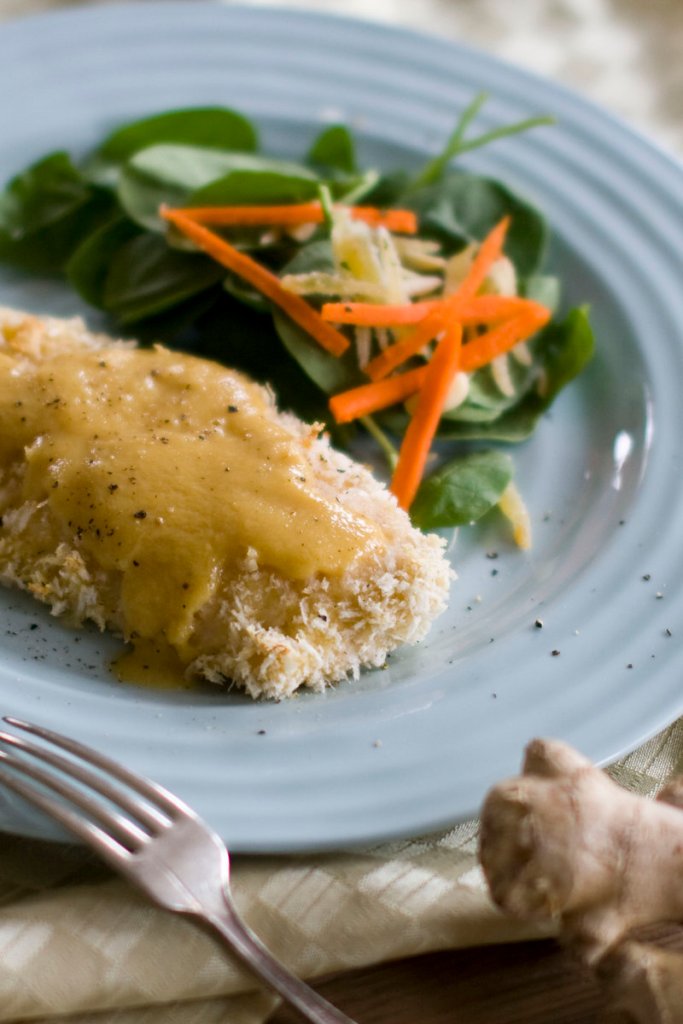People have been eating it for thousands of years, yet still no one can tell me why it should be peeled. So I don’t, and neither should you.
“It” being fresh ginger, the gnarly brown root that lives amongst the grocer’s Asian produce. And the flavor is so much better than dried, you must get to know it.
Many of us think of ginger as the powder in the spice cabinet and use it mostly for baking. In Asia, where ginger originated, it’s more a savory ingredient. That’s because fresh ginger packs tons of warm, pungent, peppery flavor that works so well with meats and vegetables.
Though they can be used interchangeably, the flavor of fresh ginger is more pronounced than dried, sporting heavy citrus, even acidic notes. In Asia, fresh ginger is an essential part of numerous classic dishes, including stir-fries, soups, sauces and marinades, as well as Indian curries.
When cooking with fresh ginger, keep in mind a couple things. First, cooking mellows the flavor. So if you want to really taste it, add some ginger at the beginning of cooking, and a bit more at the end.
Second, the strength of the ginger can vary widely by the piece. So if you’re looking for a serious hit of ginger, taste it before you add it.
Now, about that peeling. Watch cooking shows and read recipes, and you’ll be told again and again to peel your ginger before chopping, slicing or grating it. I have no idea why.
The skin is entirely edible and doesn’t change the flavor. So save yourself the time and effort, and just use your ginger as is. And the best tool for the job is a wand-style grater, such as a Microplane. These graters quickly reduce ginger root to fine shavings or pulp ideal for cooking.
When shopping for fresh ginger, look for firm, tan roots with no signs of mold or shriveling. It can be stored in the refrigerator for several weeks. But I prefer to freeze my fresh ginger. Frozen ginger lasts for months and is easier to grate than fresh.
GINGER-ORANGE CHICKEN CUTLETS
Start to finish: 1 hour (20 minutes active)
Servings: 4
1 cup orange juice
2-inch chunk fresh ginger
1 clove garlic
1 teaspoon salt
2 boneless, skinless chicken breasts
1/2 cup all-purpose flour
1 teaspoon garlic powder
1 egg
11/4 cups panko breadcrumbs
1/4 cup heavy cream
In a blender, combine the orange juice, ginger, garlic and salt. Puree until smooth, then set aside.
Carefully slice each chicken breast in half horizontally to create 2 thin halves. Place the chicken in a zip-close plastic bag, then add the orange juice mixture. Refrigerate the chicken for at least 30 minutes.
When ready to cook, heat the oven to 400 F. Coat a baking sheet with cooking spray.
In a wide, shallow bowl, mix together the flour and garlic powder. Beat the egg in a second bowl, and pour the panko into a third.
One at a time, remove the chicken pieces from the marinade, reserving the marinade. Dredge each piece of chicken first through the flour, then the egg, then the panko. Arrange them on the prepared baking sheet. Spritz the tops of the chicken with cooking spray, then bake for 25 minutes.
Meanwhile, transfer the marinade to a small saucepan over medium-high heat. Bring to a boil and cook for 3 minutes. Stir in the cream. Serve the chicken with the sauce.
Nutrition information per serving (values are rounded to the nearest whole number): 340 calories; 70 calories from fat (21 percent of total calories); 8 g fat (4 g saturated; 0 g trans fats); 100 mg cholesterol; 46 g carbohydrate; 21 g protein; 1 g fiber; 620 mg sodium.
Copy the Story Link
Send questions/comments to the editors.



Success. Please wait for the page to reload. If the page does not reload within 5 seconds, please refresh the page.
Enter your email and password to access comments.
Hi, to comment on stories you must . This profile is in addition to your subscription and website login.
Already have a commenting profile? .
Invalid username/password.
Please check your email to confirm and complete your registration.
Only subscribers are eligible to post comments. Please subscribe or login first for digital access. Here’s why.
Use the form below to reset your password. When you've submitted your account email, we will send an email with a reset code.